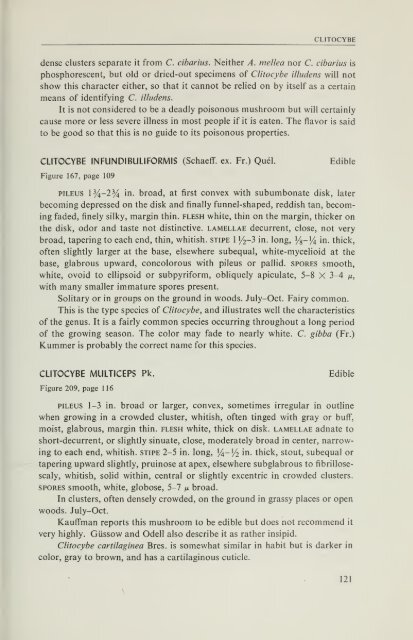You also want an ePaper? Increase the reach of your titles
YUMPU automatically turns print PDFs into web optimized ePapers that Google loves.
CLITOCYBE<br />
dense clusters separate it from C. cibarius. Neither A. mellea nor C. cibarius is<br />
phosphorescent, but old or dried-out specimens of Clitocybe illudens will not<br />
show this character either, so that it cannot be rehed on by itself as a certain<br />
means of identifying C. illudens.<br />
It is not considered to be a deadly poisonous mushroom but will certainly<br />
cause more or less severe illness in most people if it is eaten. The flavor is said<br />
to be good so that this is no guide to its poisonous properties.<br />
CLITOCYBE INFUNDIBULIFORMIS (Schaeff. ex. Fr.) Quel. Edible<br />
Figure 167, page 109<br />
PILEUS l%-2% in. broad, at first convex with subumbonate disk, later<br />
becoming depressed on the disk and finally funnel-shaped, reddish tan, becom-<br />
ing faded, finely silky, margin thin, flesh white, thin on the margin, thicker on<br />
the disk, odor and taste not distinctive, lamellae decurrent, close, not very<br />
broad, tapering to each end, thin, whitish, stipe 1 )/2-3 in. long, J4-)4 in. thick,<br />
often slightly larger at the base, elsewhere subequal, white-mycelioid at the<br />
base, glabrous upward, concolorous with pileus or pallid, spores smooth,<br />
white, ovoid to ellipsoid or subpyriform, obliquely apiculate, 5-8 X 3-4 //,<br />
with many smaller immature spores present.<br />
Solitary or in groups on the ground in woods. July-Oct. Fairy common.<br />
This is the type species of Clitocybe^ and illustrates well the characteristics<br />
of the genus. It is a fairly common species occurring throughout a long period<br />
of the growing season. The color may fade to nearly white. C. gibba (Fr.)<br />
Kummer is probably the correct name for this species.<br />
CLITOCYBE MULTICEPS Pk. Edible<br />
Figure 209, page 116<br />
PILEUS 1-3 in. broad or larger, convex, sometimes irregular in outline<br />
when growing in a crowded cluster, whitish, often tinged with gray or buff,<br />
moist, glabrous, margin thin, flesh white, thick on disk, lamellae adnate to<br />
short-decurrent, or slightly sinuate, close, moderately broad in center, narrow-<br />
ing to each end, whitish, stipe 2-5 in. long, V^-Vi in. thick, stout, subequal or<br />
tapering upward slightly, pruinose at apex, elsewhere subglabrous to fibrillose-<br />
scaly, whitish, soHd within, central or slightly excentric in crowded clusters.<br />
SPORES smooth, white, globose, 5-7 ju broad.<br />
In clusters, often densely crowded, on the ground in grassy places or open<br />
woods. July-Oct.<br />
Kauffman reports this mushroom to be edible but does not recommend it<br />
very highly. GUssow and Odell also describe it as rather insipid.<br />
Clitocybe cartilaginea Bres. is somewhat similar in habit but is darker in<br />
color, gray to brown, and has a cartilaginous cuticle.<br />
121

















